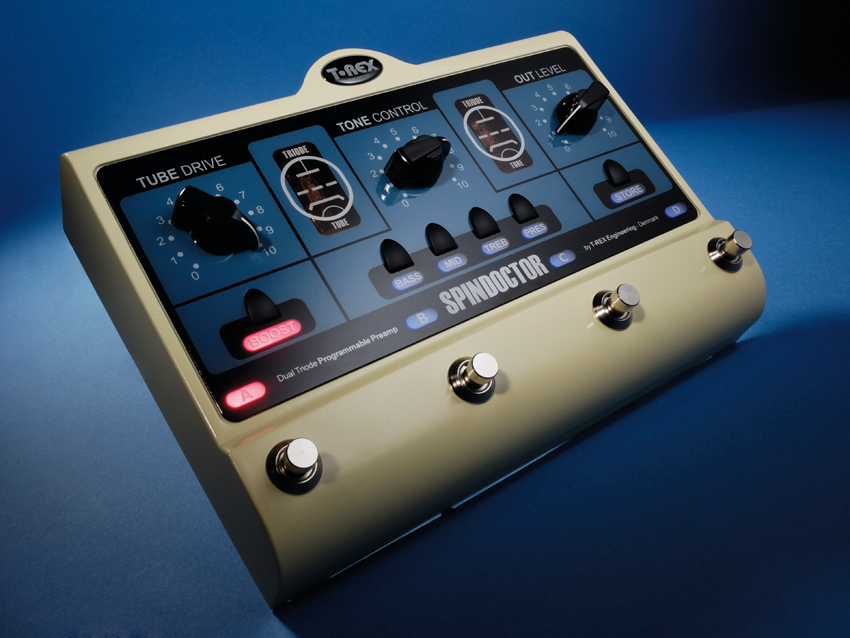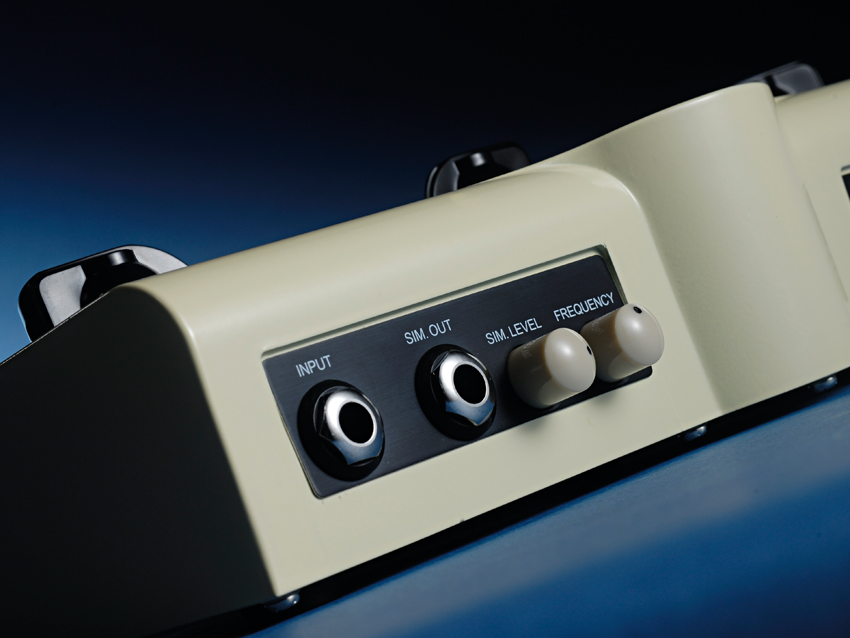MusicRadar Verdict
A fusion of old and new technologies, the T-Rex SpinDoctor proves highly desirable in both its design and tone - although it's highly priced.
Pros
- +
Fantastic tones. Novel motorised controls/channel switching.
Cons
- -
Noticeable delay when changing patches. Expensive.
MusicRadar's got your back

T-Rex SpinDoctor

T-Rex SpinDoctor
Based in Denmark, T-Rex has a great reputation for its range of high-end stompboxes used by such luminaries as Pete Townshend, David Gilmour and Carlos Santana. Here we´re looking at the T-Rex SpinDoctor, a four-channel programmable valve preamp with optional speaker simulation that can also be used as an overdrive or distortion pedal.
Design and construction
Like the other T-Rex products we've seen, the SpinDoctor is solid and beautifully constructed. The cream paintwork isn't quite what we'd have used for a snarling rock 'n' roll machine, but it has a certain retro charm.
The four footswitches are generously spaced on a raised ridge, and most of the controls are arranged behind in three groups. The first group contains the tube drive control and a boost button, while the third has the master volume control and a button for storing presets. In the middle is a single tone knob along with four buttons (bass, mid, treble, presence) for selecting which parameter to adjust. All of these pushbuttons light up when engaged, as do each of the four channel indicators.
On the rear panel there's a single guitar input and dual outputs (one with speaker simulation applied) plus a MIDI input and a connection for the DC adaptor. Two small knobs, marked sim level and frequency, allow you to fine-tune the character of the speaker simulation. These knobs are spring-mounted, meaning you can push them out of the way to avoid accidental adjustment.
In use
"In the broadest sense the SpinDoctor's tone is more Fender than Marshall although such comparisons are a slight oversimplification due to the wide range of the tone controls."
To get a complete idea of what the SpinDoctor can do, we started off using the speaker simulator, plugging straight into a mixing desk and studio monitors. The SpinDoctor has already been set up with a representative selection of sounds, ranging from totally clean to full-on overdrive, so we started by tweaking the two speaker simulator knobs. With the Frequency control too high, we found the sound became a little honky, so we backed it off to just over 50 percent - although your ideal setting will obviously depend on your setup.
Even with the speaker simulator's level control up full, the output level is initially a lot lower than on the average all-in-one modelling unit. This is mostly because the first channel is preset with a clean sound and only about 50 percent on the master volume. More overdriven settings result in a much healthier output level. Still, with the huge gain range available from the SpinDoctor, it's worth spending a bit of time balancing the output levels of the four channels because clean sounds can end up being disproportionately quiet.
Motorised controls
One of the most unique features of the SpinDoctor is the way it changes between channel settings. There are four channels, one set of controls and no numerical display, so how do you know what settings you've saved for each channel? Simple: motorised controls.
When you've tweaked the controls for a particular channel to your liking, just hit the Store button to commit it to the SpinDoctor's memory. Now, every time you return to that channel, the knobs spin impressively back to your chosen settings.
In the broadest sense the SpinDoctor's tone is more Fender than Marshall although such comparisons are a slight oversimplification due to the wide range of the tone controls. With the tube drive control turned up full, there's enough overdrive for meaty riffs (even on single-coil pickups) but things really open up when the boost feature is added.
The SpinDoctor has its own distinct preamp sound, and no doubt the onboard speaker sim has been designed with that in mind. With the frequency control set roughly in the middle of its range, the preamp sounds crisp and balanced, and while higher settings can sound a bit 'nasal', they would work well enough for adding mid-range focus to lead guitar tones.
Plugging the SpinDoctor into a guitar amp alters its function somewhat. Your bottom line default clean setting is now most likely to be 'off' (assuming you like the basic sound of your amp) so you effectively gain an extra intermediate overdrive level. As mentioned before, the SpinDoctor's combined tube drive and out level controls provide a wide output range, so once again it takes a little bit of experimentation to get the right balance between the channels.
Plugged in and live
Plugging into our test amp, a Cornford Harlequin, the SpinDoctor's powerful EQ section is great for instantly accessing a much wider range of tones than you'd expect from the minimalist Harlequin. The SpinDoctor excels in a live situation, where the vast sound palette of some of the larger modelling/FX units would be overkill. Most people don't really need a virtual truckload of amps on stage; tonal variations on a good basic amp sound are generally far more useful (and kinder to the soundman). We quickly knocked together a trial set of sounds using two channels for crunchy/meaty overdrive and two for specific EQ treatments: a Strat shimmer and a mid-range-enhanced solo tone.
Speaking of live performance, we do have one criticism: there's a noticeable delay when switching channels. This happens on plenty of other devices, but on such an expensive and otherwise excellent preamp, it really is a great shame.
Conclusions
Whether you use it for direct recording, direct-to-PA live performance or as an eloquent overdrive pedal, the SpinDoctor is a lovely product. Its tones ooze quality and the control layout is comfortable and intuitive to use. This sort of quality doesn't come cheap, though, and the price will probably be beyond the budget of most amateur players.
Still, it's a very versatile pedal, and could easily satisfy the complete tonal requirements of many players, in which case the price seems less terrifying. T-Rex has come up with a great way of combining overdrive and preamp functions, and fans of boutique valve tones should start planning a demo very soon.
MusicRadar is the number one website for music-makers of all kinds, be they guitarists, drummers, keyboard players, DJs or producers...
- GEAR: We help musicians find the best gear with top-ranking gear round-ups and high-quality, authoritative reviews by a wide team of highly experienced experts.
- TIPS: We also provide tuition, from bite-sized tips to advanced work-outs and guidance from recognised musicians and stars.
- STARS: We talk to musicians and stars about their creative processes, and the nuts and bolts of their gear and technique. We give fans an insight into the craft of music-making that no other music website can.
“A synthesizer that is both easy to use and fun to play whilst maintaining a decent degree of programming depth and flexibility”: PWM Mantis review
“I feel like that song had everything we needed to come back with”: Bring Me The Horizon’s Lee Malia on Shadow Moses, its riff and the secrets behind its tone, and why it was the right anthem at the right time
“I said, ‘Are we sure we can write a song about death?’”: The story of Mike + The Mechanics' classic No.1 The Living Years










